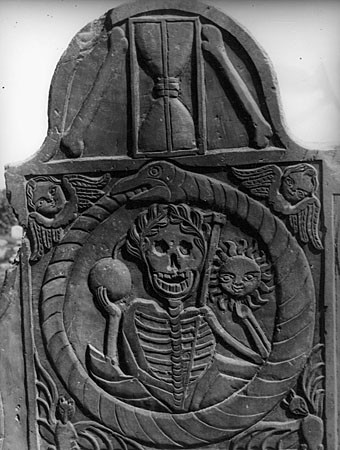A collection of skeletal carvings from the 17th and 18th century at LUNA Commons.
Update: Well they were there but the database seems to have been rearranged and these photos removed.
Previously on { feuilleton }
• Skull cameras
• Walmor Corrêa’s Memento Mori
• The skull beneath the skin
• Vanitas paintings
• Very Hungry God
• History of the skull as symbol


Thank you for these, John, they are really beautiful. And lovely to see them so clearly, unlike the degraded sandstones which feature in the North-east UK, where I live. (Although weathered stone does have a particular aesthetic of its own, it’s so nice to see the detail sometimes).
The bodiless cherubs particularly have always struck me as having a high weirdness quotient.
Which I like.
I also like the ouroborus/snake symbol. Much appreciated post.
Hi Sue. I was also surprised these had weathered so well. Must have been some tough stone they used. I was surprised by the bats as well. The symbolism is quite curiously medieval on this one, even the cherubs look like the kind of things you’d see in illuminated manuscripts. The Victorian era seemed to narrow down the range of options for funerary architecture. Skulls and bones were phased out in favour of draped urns and morose angels. When I was in Paris I wandered through most of Père Lachaise and don’t recall seeing anything this fanciful at all, despite the many otherwise fine (and costly) monuments.
Found it!
I wanted a digital copy of this gravestone. Persistence paid off. Through a succession of searches I found a copy of the central symbolism, elsewhere, which lead to a bit more data, which lead to the image of the stone on a site other than Farber.
The data is: Jayne, Susanna; 1776; Marblehead, Massachusetts.
The link at Farber would be found by searching for Marblehead, MA. Then scroll down…
Here is a direct to one (of five) images of this particular stone:
http://www.lunacommons.org/luna/servlet/detail/FBC~100~1~8063~223178:Jayne,-Susanna?sort=Name%2CDates%2CCity%2CStateOrProvince&qvq=q:StateOrProvince=Massachusetts+AND+=Marblehead+;sort:Name,Dates,City,StateOrProvince;lc:FBC~100~1&mi=25&trs=63
So, there it is!